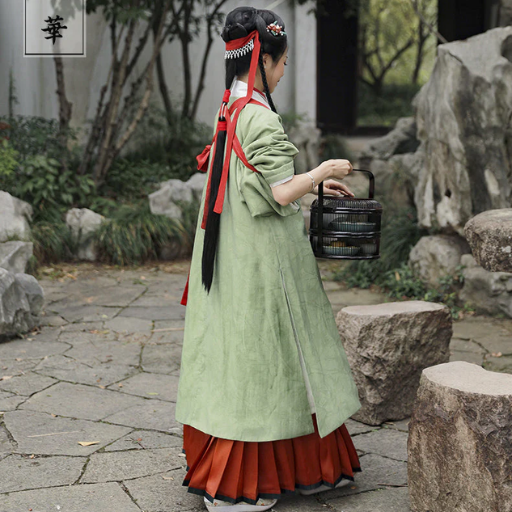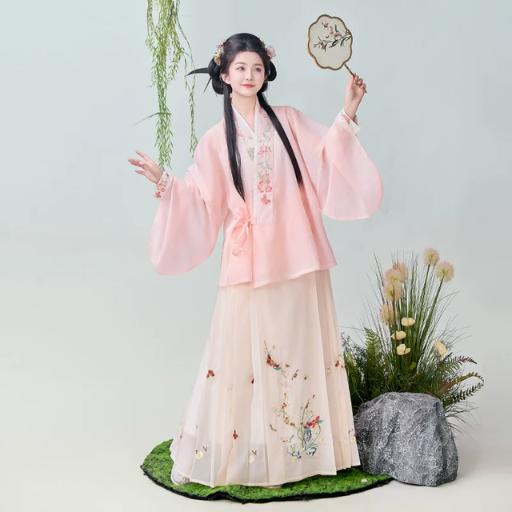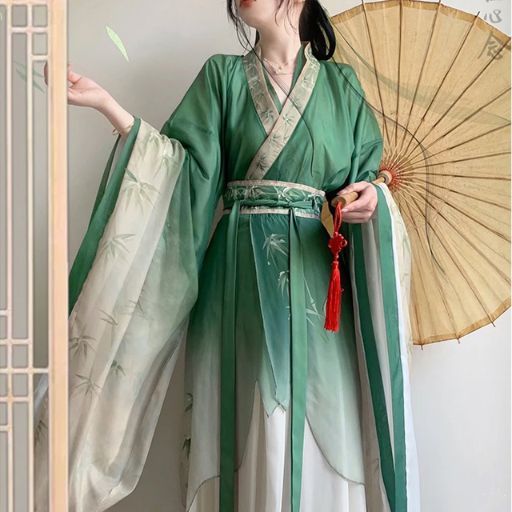Discover the captivating world of Hanfu sleeves – from their ancient origins to modern adaptations. These flowing masterpieces represent centuries of Chinese culture, artistry, and sophisticated design that continues to inspire fashion enthusiasts worldwide.
Introduction to Hanfu and Its Magnificent Sleeves

The Han Chinese costume, commonly known as Hanfu, stands as one of the world’s most elegant traditional garments, distinguished by its sophisticated embrace of the human form. Among its most striking features are the sleeves, which serve both structural and aesthetic purposes, ranging from dramatic, flowing designs worn by dancers to simple, practical styles for everyday wear.
What Makes Hanfu Special?
Hanfu, meaning “Han clothing,” represents over two thousand years of Chinese cultural heritage. This traditional attire encompasses garments from various dynasties, including the Han, Tang, Song, and Ming periods, influencing East Asian fashion throughout history.
Core Components of Traditional Hanfu
- Yi (衣) – The upper garment or robe with a distinctive cross-collar design
- Shang (裳) – The lower garment, typically a flowing skirt
- Sash or Belt – Essential for completing the silhouette
- Sleeves (袖) – The defining feature that creates grace and elegance
7M+Hanfu enthusiasts worldwide as of 2023
65%Prefer wider sleeves for authenticity and beauty
40%Increase in “wide sleeve hanfu” searches in 2023
The Cultural Importance of Sleeves in Hanfu Design

Hanfu sleeves transcend mere fashion elements – they embody profound cultural significance. The width, style, and construction of sleeves historically indicated social status, gender, and occasion. More elaborate sleeve designs were typically reserved for the upper classes and special ceremonies.
Functional and Symbolic Purposes
| Aspect | Wide Sleeves | Narrow Sleeves |
|---|---|---|
| Social Status | Higher class, formal occasions | Practical wear, working class |
| Seasonality | Versatile layering for winter | Lightweight for summer comfort |
| Symbolism | Elegance, grace, dignity | Practicality, efficiency |
| Usage | Ceremonies, performances | Daily activities, work |
The ‘water-sleeve’ style played a dual role in Chinese classical dance and drama, amplifying controlled movements with unparalleled artistry.
Comprehensive Guide to Hanfu Sleeve Types
Traditional Sleeve Varieties
| Sleeve Type | Chinese Name | Characteristics | Best Suited For |
|---|---|---|---|
| Simple Sleeves | 直袖 (Zhijiu) | Straight cut, practical design | Daily wear, official occasions |
| Bat Sleeves | 飞肩 (Feijian) | Wide, flowing appearance | Formal events, ceremonies |
| Inverted Mouth | 宽筒 (Kuantong) | Tailored, tightened at ends | Functional daily wear |
| Cloud Sleeves | 云肩 (Yunjian) | Structural creates a sparkle effect | Theater, dancing performances |
| Pipa Sleeves | 琵琶袖 | Lute-shaped, dramatic taper | Formal ceremonies, cultural events |
The Distinguished Pipa Sleeve
Named after the Chinese pipa lute, these sleeves feature a distinctive shape with a wide upper portion that gracefully tapers to a fine point. Popular during the Tang and Song dynasties, pipa sleeves were often richly embroidered and worn in ceremonial contexts, representing the pinnacle of elegant design.
Historical Evolution Through the Dynasties

Han Dynasty Innovations (206 BCE – 220 CE)
The foundational period established wide, flowing sleeves that emphasized grace and refinement. These generous designs became the template for future developments and represented the scholarly and upper-class aesthetic ideals.
Tang Dynasty Influences (618-907 CE)
- Introduction of lotus and peony motifs in sleeve decoration
- Enhanced embroidery techniques and international influences
- The peak of cultural exchange along the Silk Road affected design
- Integration of foreign artistic elements while maintaining the Chinese essence
Ming Dynasty Cultural Preservation (1368-1644)
The Ming period marked a return to traditional Chinese aesthetics with narrower, more structured sleeve designs. This era focused on preserving cultural heritage while adapting to changing practical needs and social structures.
Modern Renaissance: Contemporary Hanfu Adaptations
Current Fashion Integration Trends
$1.5BProjected global Hanfu market by 2025
30%Increase in sustainable fashion searches
25%Growth in AR fashion commerce integration
Practical Styling Tips for Modern Hanfu-Inspired Fashion
- Layer Strategically: Combine Hanfu-style tops with contemporary fitted bottoms for balanced proportions
- Choose Modern Materials: Opt for lightweight fabrics like chiffon or jersey to maintain the flowing aesthetic while ensuring comfort
- Focus on Accessories: Use traditional elements like silk sashes or jade accessories to complete the look
- Experiment with Patterns: Incorporate traditional Chinese motifs into modern silhouettes
- Select Appropriate Footwear: Pair with simple flats, platform sandals, or even stylish sneakers, depending on the occasion
Cultural Significance and Global Appeal

Symbolism in Traditional Design
Hanfu sleeves represent far more than aesthetic choices. They embody Chinese philosophical concepts about harmony between humans and nature, social hierarchy, and cultural refinement. The flowing design reflects the wearer’s connection to natural elements and adherence to traditional values.
Global Market Impact
Recent studies show that international interest in Hanfu has grown exponentially, with social media platforms like TikTok and Instagram featuring millions of posts under #HanfuStyle and #ModernHanfu hashtags. This global recognition has led to international fashion shows incorporating Hanfu elements in major fashion capitals.
Identity and Cultural Pride in Modern China
- Young Chinese increasingly use Hanfu to connect with cultural heritage
- Government initiatives like International Hanfu Day (established in 2018) promote cultural awareness
- Social media drives widespread adoption and adaptation of traditional styles
- Combines individual expression with collective cultural identity
Frequently Asked Questions
Hanfu features diverse sleeve styles including straight sleeves (practical daily wear), bat sleeves (formal occasions), cloud sleeves (performances), and pipa sleeves (ceremonies). Each type reflects different social contexts and cultural values, with wider sleeves traditionally indicating higher status and formal occasions.
Sleeve evolution reflects changing cultural aesthetics: the Han Dynasty featured wide, flowing designs; the Tang Dynasty introduced decorative motifs and international influences; the Ming Dynasty emphasized narrower, more structured styles focused on cultural preservation. Each era adapted sleeves to contemporary needs while maintaining traditional elegance.
Design factors include material type (silk allows flowing styles, sturdier fabrics maintain structure), cultural period influences, social status requirements, seasonal functionality, and occasion appropriateness. The interplay of these elements creates the diverse sleeve styles seen in historical and modern Hanfu.
Modern adaptation includes layering Hanfu-inspired tops with contemporary bottoms, using lightweight modern fabrics, focusing on minimalist combinations, and selecting appropriate accessories. Social media trends show successful integration of traditional sleeve elements with casual wear, creating culturally respectful yet practical modern styles.
Pipa sleeves, named after the Chinese lute, gained prominence during the Tang Dynasty as a symbol of musical and cultural sophistication. Their distinctive tapered shape represents the harmony between form and function, often featuring elaborate embroidery and worn during important ceremonies to display status and cultural refinement.
Conclusion: The Enduring Legacy of Hanfu Sleeves

The elegant art of Hanfu sleeves represents a remarkable journey through Chinese cultural history, from ancient imperial courts to modern fashion runways. These flowing masterpieces continue to captivate global audiences, proving that true artistry transcends temporal boundaries.
As we witness the modern renaissance of Hanfu culture, with millions of enthusiasts worldwide embracing these traditional designs, the sleeves remain the defining feature that transforms simple garments into expressions of cultural identity and artistic heritage. Whether adapted for contemporary wear or preserved in traditional form, Hanfu sleeves continue to embody the timeless Chinese values of harmony, elegance, and cultural pride.
Looking Forward: The future of Hanfu sleeves lies in the delicate balance between preservation and innovation, ensuring that these cultural treasures remain relevant while honoring their profound historical significance for generations to come.
Reference Sources
- University of Virginia: Hanfu as the New Chinese National Costume
This section discusses the new understanding of the national costume and its construction, including the isthmus of the component halfway across the arm.
- Boston University: China | Fashion.
This section provides a detailed discussion of the traditional Chinese costume for both the robe and skirt and the many different styles of dresses of Hanfu.
- Connecticut College: Power and Community in Traditional Chinese Dress
On the other hand, this section tries to dissect the more polite issues of some common aspects in exposing traditional women’s clothing of the Chinese society, such as Hanfu.







